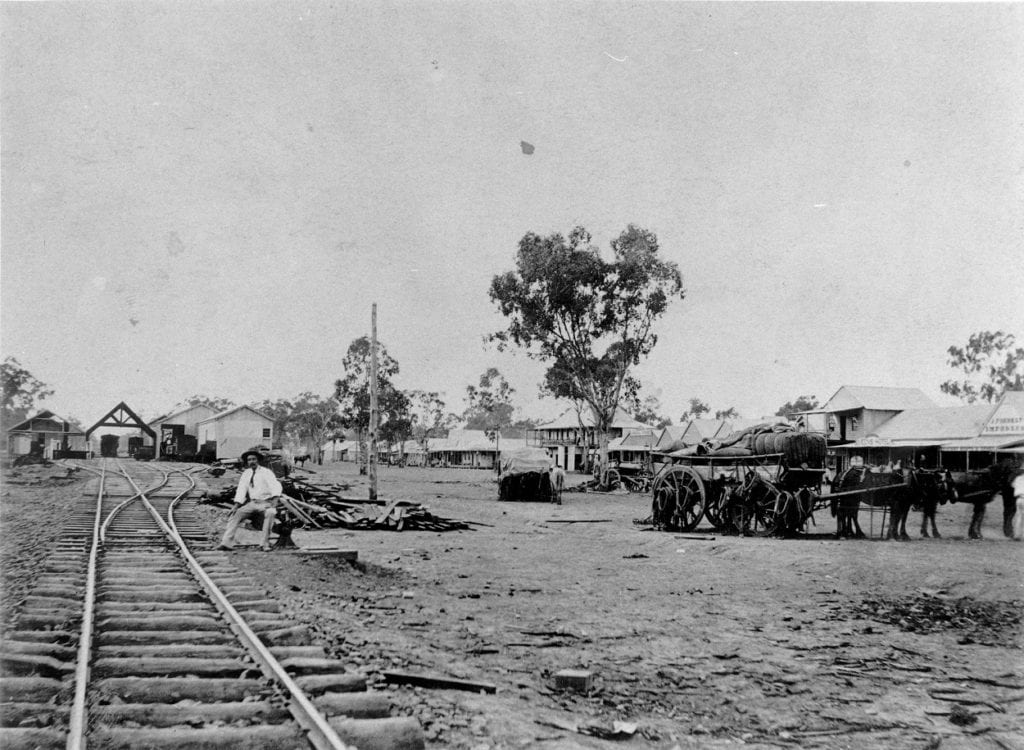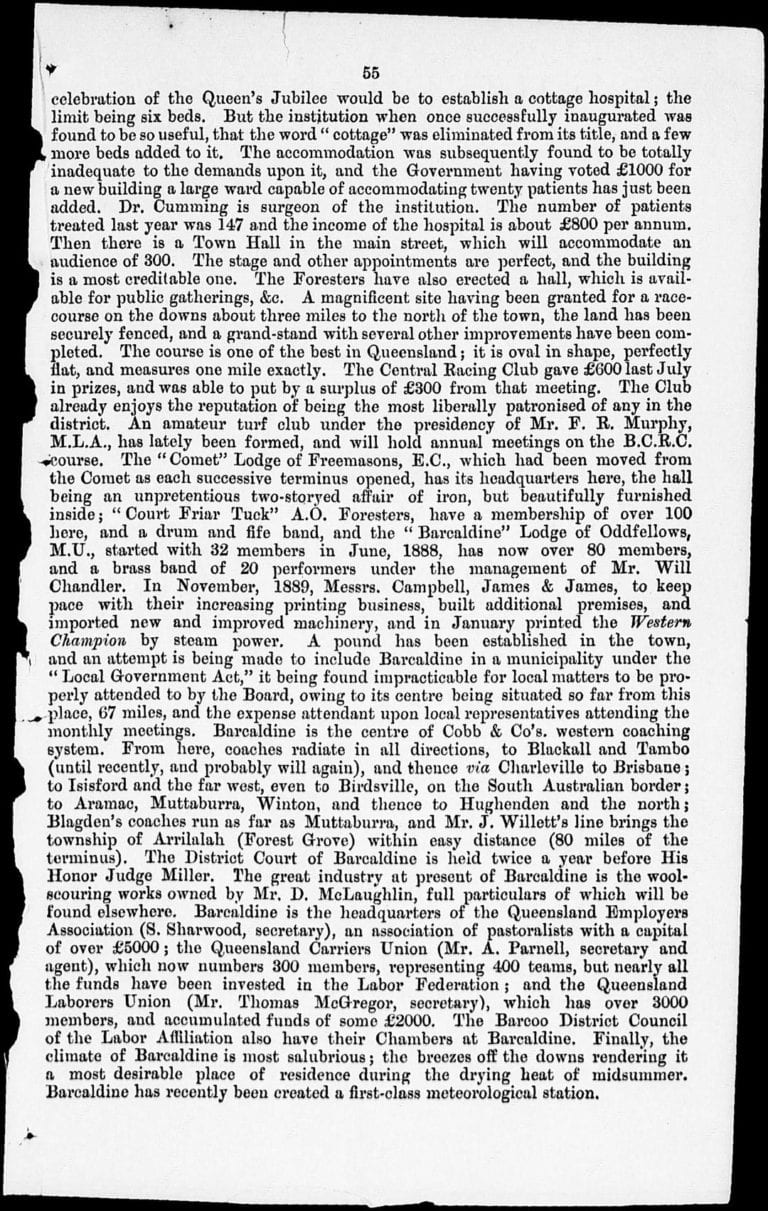ORIGINS
Barcaldine township sprang into being with the opening of the railway on 8 November 1886 and is ‘the most notable of the “instant” railway towns’ which flourished at the successive termini of the Central Railway as it was pushed westward from Rockhampton. The township was originally called Lagoon Creek, the town area being excised from Barcaldine Downs and subsequently being called Barcaldine. Barcaldine Downs of course being named after Barcaldine in Scotland.
The first mentions of the town in the newspaper can be found in ‘Jottings from the Jordan’ published in the Western Champion from 1886. The writer lived in Jericho, and recorded the exodus from that town to the new town of Barcaldine. After the town established, from 1886 the correspondent was ‘The Terminus’ who recorded the establishment and growth of the town. ‘The Sketcher’ then continued the story.
The choice of Barcaldine as the designation of the new township was due to its establishment on land leased originally Donald Charles Cameron and which, in 1865, was registered as Barcaldine Downs and Fox Hall. This man, a descendant of the clan which came to grief in the last Stuart uprising of 1745, after some years in the West Indies managing his uncle's estates, came to Australia in 1852. then years later with his eldest son, John, and two Crombie brothers, he set out for the new colony of Queensland and took up forty miles of country on the Alice River, the largest portion of which he called Barcaldine after a property in Argylshire at one time owned by bis forebears. He died in 1872 and lies buried on what now is Home Creek. Others too were venturing out into the empty land and the 1860s saw the first settlement of the Central West of Queensland; Landsborough on Bowen Downs, Cheesborough and Hodgson on Rodney, Raven and the two Paterson brothers on Corinda and Stainburn, Rule and Lacey on Coreena ...; the first two of the blocks, Return and Recovered, which were to form Home Creek were taken up by Allen and partners, and early in the 1870s Edward Wienholt established himself on Saltern Creek.
... conditions were harsh and dangerous ... life offered little or nothing in the way of comfort or luxury - tin plates and pannikins were in use at Barcaldine Downs, fat lamps and home-made candles served for light, rations, by no means lavish or sumptuous, arrived by bullock-dray at intervals of anything up to twelve months; Springsure was the seat of the nearest doctor and also the terminus of the mail-run, paddocks were unknown, dingoes bad and natives not always reliable...
... the life and work of a Station would not have been possible without the help of the men and women who, eager to try their luck and improve their position in 'Regions Caesar never knew', made their way over the few primitive tracks to find work as shepherds, shearers, ringers, cooks, teamsters and so on - Mr E Sealy remembers his father telling him that 75 teams were used to bring the material for the Barcaldine Downs shed from Pine Hill; it was their labour that enabled the 'squatters' to lick the country into shape, get the wool to the coast, surmount the hardships and difficulties confronting them and to lay the foundations of the rich heritage we enjoy.Selwyn Cowan. Barcaldine Praeterita 1958
As the railway line was brought closer to Lagoon Creek, the carriers' camp there began to assume what the Western Champion Almanack for 1891 called, with pardonable exaggeration, 'formidable proportions'; Shakespeare's (sic) Hotel, the verandah of which served as the grandstand for Barcaldine's first racecourse, was brought from Pine Hill and many of those who were serving the needs of the 370 men employed on construction work pulled up their stakes and moved to the locality where the new township was springing up on a site which, by reason of the dust and sand, the Western Champion thought most unsuitable.
Selwyn Cowan. Barcaldine Praeterita 1958
In September 1886, Lagoon Creek consisted of Shakespeare's Hotel, brought from Pine Hill, and several tents, but in a few weeks the exodus set in from Jericho, and when the station of Lagoon Creek (since called Barcaldine) was opened in December, the town had assumed formidable proportions. Although '358 miles' did not terminate the section — the line being actually carried over the downs 12 miles further west — the Government promised not to open the line at the twelve-mile, and subsequently further promised not to open a station between here and Longreach, 64 miles from Barcaldine, a place intended for a terminus, for some years to come. The 'rush' to Barcaldine was unprecedented in the annals of Central Railway history. Both Aramac and Blackall being in close proximity, each sent settlers to the new township. The proprietors of the 'Western Champion' newspaper removed their plant from Blackall, and one of Blackall's leading storekeepers also sent a portion of his stock and opened a branch. An Aramac storekeeper intended doing likewise, but noticing the place gave promise of being overdone, wisely remained where he was.
Western Champion Almanac 1891
'Lagoon Creek was no sprawling ad hoc encampment, but a properly laid out town with a rectangular grid of streets surveyed by Desgrand in September 1885 in accordance with the government regulations of the time. The town's situation on a slight ridge amidst flat terrain immediately to the south of the railway line permitted a perfectly regular street layout to be adopted and the pattern of building in the town has the same diagrammatic regularity. The half dozen hotels and the main stores and businesses are lined up along the south side of Oak Street, looking across at the railway line. The next street to the south contains the Court House, government buildings and churches. The rest of the town is filled out with wooden houses under great shady roofs, sitting on tall stumps on large sparsely planted allotments. This layout makes the town oddly lop-sided, with its centre of gravity off to the south of the single-sided main street and nothing much but the railway and open ground to the north. The way buildings were shifted in stages as the railway advanced was a remarkable feature of the development of the Central Railway line. As well as Shakespeare’s hotel, the Methodist and Catholic Churches, the government school, various railway buildings, houses and the Masonic Hall, were all picked up and moved to Barcaldine. Some had already moved before, but all found their last resting place at Barcaldine. As the town prospered, and as its future appeared secure, the light movable structures were replaced by more substantial and stylish ones'. []
Peter Marquis-Kyle http://www.marquis-kyle.com.au/comet.htm
The hotel industry was a key socioeconomic institution in Queensland during the late nineteenth and early twentieth centuries. Hotels were invariably among the first businesses to arrive in newly established towns, goldfield and other centres of economic activity. They provided an extensive range of key services for communities that were, at least initially, lacking in public infrastructure and dominated by a highly transient, male population. Apart from the provision of lodgings, meals and refreshments, selected hotels offered customers laundry, postal, stabling and blacksmith services.
K Raines, in an online Queensland Hotel's Association Review (QHA) of the impact of the hotel industry in Queensland, could have been writing about Barcaldine.


Western Champion Almanack 1891 Description



The prime reason for the initial establishment and continued growth of Barcaldine ... was to provide a service centre for those engaged in the rural industry of the area. No alternative economic base has been established subsequently and the rationale for Barcaldine's existence still lies in this servicing role... Before the postwar expansion of Government services few public service employees were posted to the township and the local population consisted of two mutually exclusive and frequently hostile groups - the town dwellers and the country dwellers... Economically the dependence of town on country was almost total. Any fluctuation in the prosperity of the country dweller was inevitably reflected in that of the town dweller.
M M Montague (Mobility and community change in Australia 1980)
